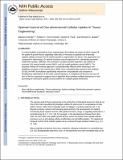| dc.contributor.author | Suthar, Bharatkumar | |
| dc.contributor.author | Northrop, Paul W. C. | |
| dc.contributor.author | Braatz, Richard D. | |
| dc.contributor.author | Subramanian, Venkat R. | |
| dc.date.accessioned | 2016-02-12T17:32:23Z | |
| dc.date.available | 2016-02-12T17:32:23Z | |
| dc.date.issued | 2014-10 | |
| dc.date.submitted | 2014-08 | |
| dc.identifier.issn | 0013-4651 | |
| dc.identifier.issn | 1945-7111 | |
| dc.identifier.uri | http://hdl.handle.net/1721.1/101170 | |
| dc.description.abstract | This paper illustrates the application of dynamic optimization in obtaining the optimal current profile for charging a lithium-ion battery by restricting the intercalation-induced stresses to a pre-determined limit estimated using a pseudo 2-dimensional (P2D) model. This paper focuses on the problem of maximizing the charge stored in a given time while restricting capacity fade due to intercalation-induced stresses. Conventional charging profiles for lithium-ion batteries (e.g., constant current followed by constant voltage or CC-CV) are not derived by considering capacity fade mechanisms, which are not only inefficient in terms of life-time usage of the batteries but are also slower by not taking into account the changing dynamics of the system. | en_US |
| dc.description.sponsorship | United States. Advanced Research Projects Agency-Energy (Award DE-AR0000275) | en_US |
| dc.description.sponsorship | Washington University (Saint Louis, Mo.) | en_US |
| dc.language.iso | en_US | |
| dc.publisher | Electrochemical Society | en_US |
| dc.relation.isversionof | http://dx.doi.org/10.1149/2.0211411jes | en_US |
| dc.rights | Article is made available in accordance with the publisher's policy and may be subject to US copyright law. Please refer to the publisher's site for terms of use. | en_US |
| dc.source | Other univ. web domain | en_US |
| dc.title | Optimal Charging Profiles with Minimal Intercalation-Induced Stresses for Lithium-Ion Batteries Using Reformulated Pseudo 2-Dimensional Models | en_US |
| dc.type | Article | en_US |
| dc.identifier.citation | Suthar, B., P. W. C. Northrop, R. D. Braatz, and V. R. Subramanian. “Optimal Charging Profiles with Minimal Intercalation-Induced Stresses for Lithium-Ion Batteries Using Reformulated Pseudo 2-Dimensional Models.” Journal of the Electrochemical Society 161, no. 11 (October 2, 2014): F3144–F3155. | en_US |
| dc.contributor.department | Massachusetts Institute of Technology. Department of Chemical Engineering | en_US |
| dc.contributor.mitauthor | Braatz, Richard D. | en_US |
| dc.relation.journal | Journal of the Electrochemical Society | en_US |
| dc.eprint.version | Final published version | en_US |
| dc.type.uri | http://purl.org/eprint/type/JournalArticle | en_US |
| eprint.status | http://purl.org/eprint/status/PeerReviewed | en_US |
| dspace.orderedauthors | Suthar, B.; Northrop, P. W. C.; Braatz, R. D.; Subramanian, V. R. | en_US |
| dc.identifier.orcid | https://orcid.org/0000-0003-4304-3484 | |
| mit.license | PUBLISHER_POLICY | en_US |
| mit.metadata.status | Complete | |
